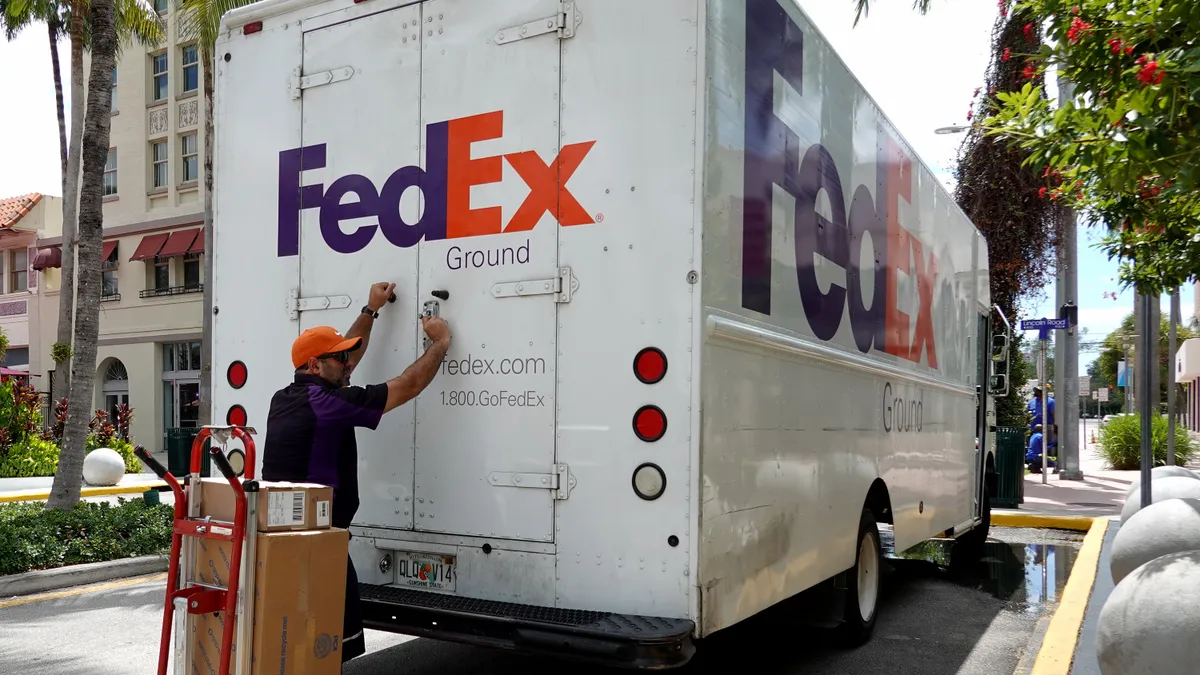From softening demand to climbing labor costs, 2023 proved to be a challenging year for FedEx and UPS.
Both carriers moved to right-size their networks in the face of waning package volumes while navigating testy union disputes. Meanwhile, FedEx and UPS shippers capitalized on the excess supply by securing discounted delivery prices, but rates are poised to jump again in the coming weeks.
These shifting market dynamics can be seen in data from FedEx, UPS and third parties. Read on for six charts that explain the delivery giants' volatile year.
Carriers face weak demand
FedEx and UPS grappled with soft demand throughout the year, extending a slump that emerged in 2022 as the pandemic-fueled e-commerce boom cooled off and shippers navigated a cloudy economic climate. But one company has fared better than the other of late.
For the quarter ending September 30, UPS weathered a 10.8% decline in average daily volume year-over-year. The company saw many customers divert packages to other carriers during its contract negotiations with the International Brotherhood of Teamsters in the summer.
UPS delivery demand shrinking
"From a demand perspective, August proved to be the most challenging, as some customers waited for the ratification of our Teamster contract, before returning volume to our network," CEO Carol Tomé said in an October earnings call. "Since contract ratification, we've been gaining volume momentum."
FedEx's demand woes eased for the quarter ending August 31, with the combined average daily volume at its Express and Ground units dropping less than 1% year-over-year. The company was one of the beneficiaries of diversions during the UPS-Teamsters negotiations.
FedEx volume dwindles over two years
"Across Ground and Express, volumes improved sequentially, aided by the threat of a strike at our primary competitor," EVP and Chief Customer Officer Brie Carere said in an September earnings call.
FedEx, UPS offer up rate discounts
As shipping demand faltered, FedEx and UPS offered up pricing discounts to draw more volume into their networks.
Ground parcel delivery rates have fallen as a result, with the TD Cowen/AFS Freight Index recording a year-over-year decline in the category for Q3. Ground parcel pricing is projected to decline again in the fourth quarter due to softer peak season shipping activity.
Ground parcel delivery costs fall YoY, first time since 2019
Shippers are reaping the benefits of improved negotiating power, with UPS customers Rent the Runway and Macy's touting more favorable delivery contracts secured earlier this year.
“Delivery expense has been a part of some of the cost savings initiatives that we’ve thought about, which impacts the combination of the placement of our goods within our system and also how we think about the processing of our delivery,” Macy's CFO and COO Adrian Mitchell said on an August earnings call.
Carriers roll out lower annual rate increases
Although pricing power has tilted in favor of shippers, FedEx and UPS customers still have to be wary of the carriers' annual rate increases.
Both companies are hiking their 2024 rates by 5.9% on average. That's a step down from their 2023 increases, but it's still higher than what they rolled out in 2020 prior to the COVID-19 pandemic.
FedEx and UPS' 2024 rate hikes smaller than 2023
“The price adjustments reflect incremental costs associated with the current operating environment, while enabling FedEx to continue investing in service enhancement, fleet maintenance, technology innovations, and other areas to serve customers more effectively and efficiently,” FedEx said in announcing its rate increase in August.
Rate hikes vary depending on shipping characteristics, with packages that are heavier or traveling over longer distances generally seeing larger increases than the 5.9% average.
UPS hit with higher labor costs
For UPS, higher shipping rates can help it offset costs tied to its new five-year contract with the Teamsters. The roughly 330,000 UPS employees represented by the union will see wage gains that outpace the previous agreement. From 2023 to 2028, general wage increases will total $3.35 more an hour compared to the previous contract’s gains.
UPS Teamsters see larger annual pay bumps in new contract
UPS is also mitigating labor costs by streamlining its package sortation process, from expanding its RFID initiative to leveraging automation. Additionally, the company uses AI and machine learning to adjust its network capacity in times of waning demand, like when it was in negotiations with the Teamsters.
The effects of the UPS-Teamsters contract are poised to ramp up wage pressure for other logistics companies. FedEx also increased wages for certain U.S. employees this year, but the company didn't specify eligibility requirements or to what extent wages increased.
Transit times improve for deliveries
Despite a challenging stretch for FedEx and UPS, company executives have reported strong service levels throughout the year in earnings calls. This coincides with a broader industry improvement in on-time delivery performance and transit times.
Transit times stay low throughout 2023
Shippers tapping into a diverse mix of carriers, a lack of pandemic-era capacity constraints and companies moving inventories closer to end consumers have all contributed to improving delivery speeds this year.
Maintaining reliable service levels can position FedEx, UPS and other carriers for success in the future after a turbulent 2023.
"Through all of this, we remained focused on controlling what we can control, and are continuing to adjust the network to match volume levels, and deliver industry-leading service to our customers," UPS CFO Brian Newman said in an October earnings call.














